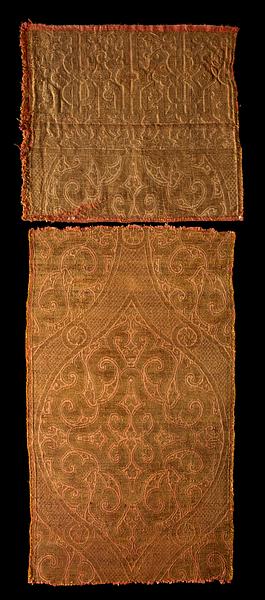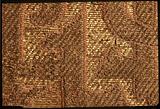Two lampas-woven textile fragments, silk and gilded lamella of animal substrate, both spun around a silk core and woven flat
Eastern Islamic area; mid-13th century
H: 28.5; W: 3.,5 cm (4/1993)
H: 51; W: 30 cm (15/1989)
The Persian historian Rashid al-Din wrote about two tents that the Mongol khan Hülegü received in 1255 and 1256 as gifts when he was near Balkh and Samarkand. The tent material is described as “gold on gold,” and this is precisely the effect that this type of textile with different woven metal threads made when it was new.
There is much indication that “golden” textiles of this kind were made in the eastern part of the Islamic world, but we do not know precisely where. When a textile’s lamella is gilded paper, it suggests a closer link to China, whereas a gilded lamella of animal substrate suggests that the place of manufacture was farther to the west.
Inv. no. 4/1993 & 15/1989
Published in:
4/1993
Kjeld von Folsach and Anne-Marie Keblow Bernsted: Woven Treasures: Textiles from the World of Islam, The David Collection, Copenhagen 1993, cat.no. 17;
Kjeld von Folsach: Art from the World of Islam in The David Collection, Copenhagen 2001, cat.no. 636;
Kjeld von Folsach: “A set of silk panels from the Mongol period” in Sheila Blair and Jonathan Bloom (eds.): God is beautiful and loves beauty: the object in Islamic art and culture, New Haven 2013, p. 232, figs. 222b and 223;
Eiren L. Shea: Mongol court dress, identity formation, and global exchange, Abingdon 2020, p. 31 and note 137;
15/1989
Kjeld von Folsach: Islamic art. The David Collection, Copenhagen 1990, cat.no. 394;
Kjeld von Folsach and Anne-Marie Keblow Bernsted: Woven Treasures: Textiles from the World of Islam, The David Collection, Copenhagen 1993, cat.no. 17;
Kjeld von Folsach: Art from the World of Islam in The David Collection, Copenhagen 2001, cat.no 636;
Kjeld von Folsach: “A set of silk panels from the Mongol period” in Sheila Blair and Jonathan Bloom (eds.): God is beautiful and loves beauty: the object in Islamic art and culture, New Haven 2013, p. 232, fig. 222b;
Eiren L. Shea: Mongol court dress, identity formation, and global exchange, Abingdon 2020, p. 31 and note 137;


